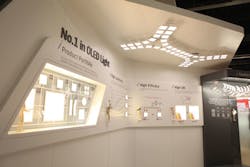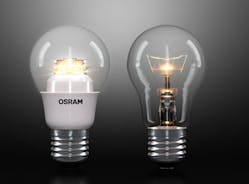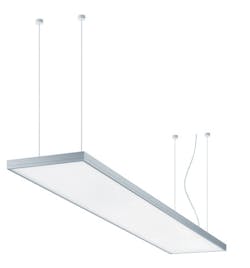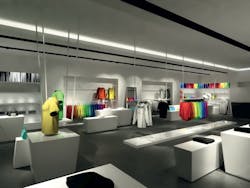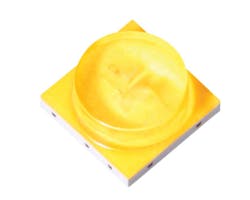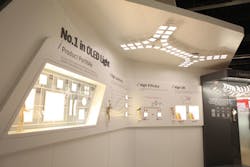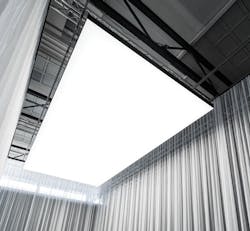The massive Light+Building fair revealed a seemingly unlimited variation in lighting product designs, but MAURY WRIGHT reports that the common themes that ran through the exhibits centered on efficient SSL sources, more innovative lighting including tunable features, and a variety of control strategies.
While Light+Building (L+B) eclipsed all other lighting events in scale, the massive exhibition didn’t magically reveal a neat path forward for the lighting industry in general, or the LED sources that are taking over the industry. Energy efficiency clearly remains important, but the quest for better light quality and features such as tunable lighting continues. Moreover, the large L+B exhibit space revealed perhaps even more uncertainty in how best to control solid-state lighting (SSL) for optimum energy savings, convenience, and realization of applications such as human-centric lighting, which requires a dynamically tunable spectrum.
Human-centric lighting was a sufficiently significant trend at L+B that the LightingEurope organization presented a walking map of such demonstrations around the fairgrounds. Indeed, the organization is targeting the application with its SSL-erate initiative that was heavily promoted at the fair.
Here, however, let’s progress through some key technology and lighting exhibits at the fair that all are tied to the central themes of light quality, dynamic control, and efficiency. We’ll cover topics ranging from retrofit lamps to luminaires to light sources.
Retrofit lamps
We can’t seem to get away from the retrofit lamps space, because the technology is simply the first touch point for most people when it comes to LED lighting. But what was different at L+B was the focus on light quality and aesthetics in lamps. For example, Philips Lighting and Osram hosted eerily similar demonstrations of low-output A19 lamps with very elegant designs.
The Osram LED Superstar Classic A40 is a 40W-equivalent lamp that is designed to more closely mimic a clear incandescent lamp in both the on and off states (Fig. 1). Likewise, the Philips Master LED (also referred to as LED Clear Classic) looks very much like a filament lamp. Both designs appear to use a light guide that functions somewhat like a filament with the LEDs hidden in the base. Although the lamps do have a white plastic neck, it’s hard to envision an application for a clear incandescent lamp in which these LED products wouldn’t serve admirably.
The other story in retrofit lamps was in more products with integrated wireless controls for on-off, dimming, and in some cases color selection. Philips perhaps led the way with more Hue products including both a white-only Hue Lux version and a new control product called Hue Tap. We covered those products in more detail in an earlier online story. And there were numerous other wireless lamps demonstrated based on ZigBee from the likes of Samsung, LG Electronics, Osram, and others.
But use of the ZigBee standard for wireless isn’t universal. Megaman, for example, announced its Ingenium Smart Lighting family at L+B. The family includes lamps with Bluetooth support for simple smartphone control (Ingenium Blu), and more complex systems that rely on a proprietary wireless scheme (Ingenium RF). The latter family includes lamps, wall panels, dimmer modules, and a Wi-Fi bridge with support for as many as 288 lamps on one network.
The diversity of network options will remain a challenge for the industry until some movement is made toward at least de facto standardization. But that may not happen soon and companies such as Osram are preparing for a multi-network environment.
Indeed, a highlight of the Osram exhibit was the new Lightify product concept. The tablet-like controller can be used to set light levels and control color spectrum. Osram said the product is due on the market this fall. But the more interesting angle is that the company will support ZigBee, Wi-Fi, DALI (digital addressable lighting interface), and perhaps other lighting networks or interconnects.
Office lighting
Moving past lamps, one key application for tunable lighting is in the office environment where the right type of lighting and tunability can enhance worker productivity. Zumtobel demonstrated several office-centric products at L+B with different approaches to tunable CCT. For instance, the Sequence family of luminaires uses a series of modular light engines and DALI controls to deliver different CCTs in ambient indirect light and direct task light from a single luminaire. We covered the Sequence series in an L+B preview in our March/April issue of Illumination in Focus.
Much of Zumtobel’s work in the office segment has been guided by research conducted by the company in conjunction with research organization Fraunhofer IAO that is focused on technology management. A study showed that office workers prefer a combination of indirect and direct light and the ability to control the lighting in their work area.
At L+B, Zumtobel also demonstrated the Light Fields planar lighting product that provides the ability to deliver light over the range of 3000K–6000K CCT (Fig. 2). The luminaires use TunableWhite modular LED light engines developed by Zumtobel. As you can see in the photo, however, the luminaire design utilizes a planar optic that the company calls MPO+ (micro-pyramidal optic), which eliminates glare, hides the individual LEDs, and provides optimal lighting on computer displays.
DC power distribution
Perhaps the biggest news in office lighting at L+B, however, was the Philips announcement that it was involved in a major project with financial consultancy Deloitte, equipping a new Amsterdam office with LED lighting powered by a DC grid with the power delivered via Power-over-Ethernet (PoE) technology. We covered the details of the announcement in more detail in an earlier online article. The PoE connection will both supply power to office luminaires and serve as a comprehensive network that allows the company to optimally control light for worker productivity and energy savings. For more details on lighting powered by DC grids, see our feature article from the March/April issue of Illumination in Focus.
The PoE announcement was bundled with a number of other network-centric announcements from Philips at L+B. The company announced connected lighting systems for indoor and outdoor applications. For example, the Intelligent Warehousing platform targets applications where there is only sporadic worker presence in any given area of a large warehouse and where adaptive controls can truly minimize energy usage. The company also debuted the outdoor IntelligentArea platform for applications such as airports and harbors and demonstrated connected-city offerings for lighting networks.
Retail lighting
The retail lighting space, meanwhile, was a hot topic at L+B and in past articles we’ve discussed the retail market and how lighting impacts shoppers in detail. Companies such as Xicato, with the Vibrant family of light engines, have touted how LED products can accentuate saturated colors to boost sales. But Zumtobel is pursuing a different path to boost retail sales with LED lighting products designed around the Limbic Model.
The Limbic Model was developed by Munich-based consultancy Gruppe Nymphenburg in partnership with Zumtobel. A laboratory study revealed that groups of people with similar personality traits prefer similar lighting environments. The research identified seven different personality categories and studied how grouped participants responded to different lighting scenarios in a retail point-of-sale scenario.
Following the study, the researchers identified three primary personality types that could be targeted with customized lighting schemes by retailers. The groups are labeled Balance (traditionalist and harmonizers), Stimulance (adventures and hedonists), and Dominance (performers and disciplinarians).
At L+B, Zumtobel demonstrated different lighting schemes for the groups. For example, Fig. 3 shows a retail display optimized for the Stimulance group. That group would prefer lower ambient levels with clearly noticeable 5000K accent lighting on the merchandise. The Dominance group would prefer higher ambient light levels with little visible accent lighting, while the Balance group would fall within the two extremes.
Now, a store can’t dynamically detect the personality of customers that walk through a door and adapt the lighting. But a shop that sells adventure goods could infer the type of shopper most likely to visit, and likewise a luxury clothing store might expect more shoppers from a different group. Zumtobel, meanwhile, supports the research with a variety of LED-based lighting products including the Supersystem modular SSL family, the Iyon track family, the Diamo downlight family, and other luminaires.
Mixing CCTs for retail
Philips Lighting demonstrated yet another approach to retail lighting for high-end clothing at L+B. The company introduced the CrispWhite concept at the fair. The products mix 3000K and 4000K CCT light to present both whites and colors in the best possible way. The 4000K light allows the eye to perceive bright intense whites while the 3000K light provides a warmer ambience and renders saturated colors in a vivid manner. Philips will also target the technology at food retail applications.
The CrispWhite introduction was a soft launch at L+B. We expect to see more detailed product information emerge at Lightfair International shortly after this issue goes to press. Philips showed the technology in the Stylid family of track fixtures at L+B and said that it will make the technology available in both replacement lamps and other luminaires later this year.
The CrispWhite technology is enabled by a CrispWhite chip-on-board (COB) LED that has yet to be announced by Philips Lumileds. Moreover, Philips Lighting will ultimately make the technology available to other lighting manufacturers in a module sold in the company’s Fortimo family of products. Indeed, the Stylid family uses a Zhaga-compliant module and Stylid is also the fixture behind the lighting renovation that we previously covered at Amsterdam’s Rijksmuseum.
LEDs at L+B
Having broached the packaged LED space with the Lumileds mention, let’s also discuss other LED news that broke around L+B. The component news was sparse, but an important trend emerged — the broad move of mid-power LED manufacturers to flip-chip manufacturing and much smaller minimalist packages.
Just prior to L+B we covered the Samsung introduction of the LM131A mid-power and LH141A high-power LEDs that are based on a flip-chip design and are essentially supplied as chip-scale packages (CSPs). Lumileds had pioneered that approach with high-power LEDs a year earlier. And Samsung had signaled its intent to offer such a product during a Strategies in Light keynote back in February.
A number of additional companies exhibited such LEDs at L+B. Toshiba, for example, announced the TL1WK LED series that is the next progression of the company’s gallium-nitride-on-silicon (GaN-on-Si) technology. The company said the product is 90% smaller in terms of mounting area relative to the previously announced GaN-on-Si LEDs in legacy plastic mid-power packages. In this instance, the silicon substrate was not the story so much as the chip architecture and package, although it’s worth noting that the company has yet to ship silicon-based LEDs in volume. Toshiba said the new LEDs would deliver efficacy in the 130-lm/W range and also enable a narrower beam pattern for directional lamps.
Lextar also demonstrated a flip chip at the fair in what it calls a White Chip — a term also used by Samsung in the past. The white-chip moniker implies the white coating that must be applied to the sides of the sapphire to reflect blue light back into the chip. The sapphire chip is topped with a molded phosphor compound in the Lextar LED.
With the movement to CSPs, however, there will be a change in the way some SSL manufacturers interact with the LED makers. Only the largest lighting companies will have the manufacturing resources to buy CSP LEDs and install them directly onto circuit boards. In many cases, SSL manufacturers that have built their own light engines in the past will have to buy modular products to access the CSP LED technology. Lumileds, for instance, refers to such dealings as level 2 engagements and says that a transition to modules is largely underway even with LEDs in traditional packages.
More mid-power features
Epistar is another company that is leveraging flip-chip technology and that has already faced the challenge of selling flip-chip die since the company only sells chips, as opposed to packaged LEDs. Epistar’s customers often package the chips and sell the finished packaged LED product or integrate the bare chips directly into lighting products.
Epistar claims it has taken flip-chip technology beyond the rest of the industry in terms of functionality realized on bare die. The company said it has constructed monolithic high-voltage LEDs with the LED chip segregated into multiple emitters in the back end of the manufacturing process with no bond wires required. At L+B, the company demonstrated tiny candelabra LED lamps made by an undisclosed LED customer. Presumably the lamp design was enabled by the high-voltage LEDs that Epistar offers in 12–50V versions.
Other recent mid-power LED trends that continued at L+B included higher-power operation and features that have been more commonly found in high-power LEDs. For example, LG Innotek demonstrated the 3030 IOL (Integrated On Lens) LED at the fair (Fig. 4). The 3×3-mm LED looks more like a high-power component and, as the name implies, has a primary optic integrated in the package. The company said the optic delivers a wider beam pattern, meaning that fewer components are required in SSL products, and a product such as a linear fixture can have the diffuser located much closer to the LEDs without the LED point sources being visible. The smaller gap results in lower-profile fixtures, and is a goal that other manufacturers such as Samsung have attacked by adding lenses on LED modules in what the company calls a Lens-Attached Module.
OLED developments
OLED light sources were also prevalent at L+B, although the application of OLEDs in lighting remains limited to niche applications as we discussed in a recent feature article. Another LG business — LG Chem in this case — had an impressive display of both bare panels and partner products on its stand.
Fig. 5 shows the 320×320-mm panel that LG Chem revealed for the first time at the fair. The most typical panels being used in actual OLED lighting products today are around 125 mm on a side, and LG said that the new panel is the largest on the market. Moreover, the panel delivers 60 lm/W in efficacy and CRI of 90, much like the company’s top-end smaller panels. LG said it will push efficacy to 100 lm/W in OLED panels this year. The photo also shows the Acuity Trilia OLED luminaire mounted on the booth ceiling. That product uses the smaller LG panels. You can also see some of the company’s flexible OLED panels in the photo.
Philips and Osram demonstrated new OLED products at L+B as well. Philips introduced the FL300 panels that had been hinted at in the previously linked feature article. The new panel delivers 300 lm whereas the prior GL350 panel delivered 200 lm. The company showed a stylish new luminaire using the panels. Osram, meanwhile, showed a ceiling fixture that was more artwork than luminaire, and that was designed by well-known lighting designer Werner Aisslinger.
Light and building integration
We’ll close with one of the most compelling demonstrations at the L+B fair — the Philips OneSpace luminous ceiling (Fig. 6). At various conferences over the past few years, many speakers have espoused the concept that LED and/or OLED technology would ultimately allow architects to specify lighting just as they do other building materials. That vision is moving closer to reality on many fronts, and Philips says the OneSpace product can serve both to deliver dramatic illumination and as a room ceiling.
OneSpace integrates arrays or meshes of closely-spaced LEDs with a textile material so the ceiling can produce light. The company said the product absorbs sound to optimize the function of spaces such as conference rooms while delivering homogenous light.
Philips will sell OneSpace as a customizable product in panels as large as 3×10m. The product is designed to resemble natural daylight. Moreover, the panels can be dimmed for ambience and also serve as safety lighting in rooms where they are installed, eliminating the need for additional light sources.
